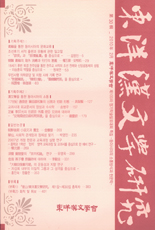학술논문
耳溪 洪良浩의 書論 小考
이용수 126
- 영문명
- A Study on Yigye Hong Yang-ho’s Calligraphic Theory
- 발행기관
- 동양한문학회(구 부산한문학회)
- 저자명
- 황병호(Hwang, Byeong-ho)
- 간행물 정보
- 『동양한문학연구』東洋漢文學硏究 第31輯, 443~474쪽, 전체 32쪽
- 주제분류
- 어문학 > 한국어와문학
- 파일형태
- 발행일자
- 2010.08.30
6,640원
구매일시로부터 72시간 이내에 다운로드 가능합니다.
이 학술논문 정보는 (주)교보문고와 각 발행기관 사이에 저작물 이용 계약이 체결된 것으로, 교보문고를 통해 제공되고 있습니다.

국문 초록
이 논문은 조선후기 국내외에서 학문적인 역량이 탁월했을 뿐만 아니라 서예가로 높은 평가를 받았던 홍양호의 서화론에 관하여 고찰한 것이다. 그의 서화론은 크게 두 가지로 대별되는데, 하나는 홍양호의 서론 중 정신적으로 추구하고 있는 지향점이 무엇인가를 파악하는 ‘書論의 指向’이고, 다른 하나는 서예의 실천적이고 기법적인 면을 다룬 ‘書論의 實際’이다. 前者는 다시 象의 중요성을 밝힌 ‘象의 重視’와 글씨의 자연스러움을 추구한 ‘自然追求’로 나누었다. 후자는 개인의 성정을 드러낼 수 있는가를 다룬 ‘性情表出’과 감평의 기준을 다룬 ‘鑑評技法’으로 나누어 파악하였다. ‘象의 重視’에서 홍양호는 文字學과 『周易』의 象數學을 통해 ‘象’을 중요시 여긴 점이다. 홍양호보다 앞서 周易을 書論에 적용한 대표적인 인물로 玉洞李漵를 들 수 있는데, 그의 『筆訣』은 易理에만 너무 치우쳤다는 평가를 받고 있다. 다음으로 ‘自然追求’에서는 서화가 자연에서의 멋을 구해야 함을 인식하고 인위적인 기교를 배격하여 억지로 잘 쓰려고 했던 당대 서풍을 비판하였다. 이는 후대 서화가로 이름난 李三晩의 ‘順自然觀’에서 더욱 정치한 이론을 낳게 한다. ‘性情表出’에서는 부단한 노력과 바른 자세와 정신을 갖추지 않고는 도달할 수 없음을 밝혔다. 마지막으로 ‘鑑評技法’에서는 그는 한때 유행했던 ‘時體’를 부정하고 정통 서학의 맥이라 할 수 있는 북해 이옹의 서체를 익혀야 할 것을 역설하였고, 종국에는 왕희지를 추구할 것을 설파하고 있다. 대다수의 서예가들은 왕희지를 높이평가하고 있으나 홍양호는 서예감평의 기준을 ‘古意’ 유무에 따라 판단하기에 이른다. 요컨대 그의 書論은 象→自然→硏鑽→古意로 요약된다. 홍양호는 ‘筆訣’이 있었으나 현존하지 않으므로 본 논고에서는 그의 문집에 남아있는 서론적인 부분만을 발췌 정리하여 사라진 필결의 내용도 추정해 보고자 했다. 뿐만 아니라 그는 당대 최고의 문장가라는 사실, 중국을
자주 사행한 일, 왕실과의 긴밀한 관계, 선대로부터 내려온 수장이 홍양호 후대까지 수장 정리되어온 일련의 관계에서 입증하기에 부족함이 없다. 또한 그의 서화에 대한 논의는 후대 서화 이론가에게 끼친 영향을 통해서도 재평가할 여지가 있음이 확인 되었다. 본고에서는 이론적인 면만을 다룬 한계점이 있으나, 이 연구를 통해 서화 비평과 서화수장 연구에 바탕으로 삼고자 한다.
영문 초록
This study examined the calligraphic theory of Hong Yang-ho, who won fame at home and overseas in the late Chosun Dynasty not only for his outstanding academic competence but also as a calligrapher. His calligraphic theory can be discussed largely in two directions. One is ‘the goal of his calligraphic theory,’ which is to find what Hong Yang-ho’s calligraphic theory aims at, and the other is ‘the reality of calligraphic theory,’ which deals with the practical and technical aspects of calligraphy. In this study, the former was again sub-divided into ‘emphasis on image,’ which explains the importance of image, and ‘pursuit of nature’, which pursued the being natural of characters. The latter was also subdivided into ‘expression of disposition,` which dealt with whether to be able to expression individuals’ disposition, and ‘appreciation and evaluation
technique,’which dealt with criteria for appreciation and evaluation. In ‘emphasis on image,’ Hong Yang-ho attaches importance to ‘image’ through graphonomy and Hsiang-shu-hsueh in I-Ching. In Korea, a representative person who applied I-Ching to calligraphic theory is Okdong Lee Seo, and it is believed that Hong Yang-ho might be influenced by him, and Lee Seo’s Pilgyeol was criticized for its excessive inclination to the theory of I-Ching. Next, with regard to ‘pursuit of nature,’ Hong Yang-ho maintainedthat calligraphy and art should find beauty in nature and artificial techniques should be excluded, and criticized the calligraphic style in his days, which sought invented beauty. Later, this position led to the birth of a further refined theory in Lee Sam-man’s ‘view of pure nature.’ With regard to ‘expression of disposition,’ he suggested that one cannot
attain the expression of disposition without unceasing efforts as well as right attitude and mind. Lastly in ‘appreciation and evaluation techniques,’ he denied ‘temporary styles’ that were popular for some time, and asserted learning Bukhae Li Yong’s calligraphic style and ultimately pursuing Hui-Chih Wang. Most of calligraphers appreciated Hui-Chih Wanghigh, but Hong Yang-ho came to judge based on whether to have `intention’ as a criterion for appreciation and evaluation. In short, his calligraphic theory is summarized into image, nature, hard pursuit, and intention. Among the four, intention was what Hong Yang-ho mentioned most frequently and attached the highest importance to. Hong Yang-ho wrote ‘Pilgyeol’ but is not extant, so this studytried to estimate the contents of Pilgyeol by extracting parts related to calligraphic theory from his writings. Furthermore, the discussion of this study is supported by the fact that Hong Yang-ho was the supreme writer in his days, his frequent diplomatic missions to China, his close relationship with theroyal family, and materials transmitted from hisancestors and handed down to his descendents. Furthermore, it was confirmed that discussion on his calligraphy and art needs to be reevaluated through his influence on other calligraphic theorists. This study had a limitation as it coveredonly the theoretical aspect, but its results may provide a base for further research on calligraphy and art criticism and collection.
목차
Ⅰ. 序論
Ⅱ. 洪良浩書論의 指向
Ⅲ. 洪良浩書論의 實際
Ⅳ. 結論
키워드
해당간행물 수록 논문
- 朝鮮前期 園林文化의 한 局面
- 峿堂 李象秀의 『史記』 評述에 대하여
- 『천주실의』에 대한 문학적 접근
- 白雲 沈大允의 儀禮正論에 대한 小考
- 조선후기 영남선비들의 여행과 공간감성
- 18세기 文學觀의 변화와 ‘개인’과 ‘개체’의 발견(1)
- 「遊金剛錄」에 나타난 再思堂 李黿의 산수 인식과 그 정신사적 의미
- 전근대 동아시아 敍事學의 지평과 한국 고전소설의 위상
- 佔畢齋 金宗直에 대한 退溪 李滉의 評價
- 점필재 김종직 연구에 대한 반성적 전망
- 동아시아 海洋神仙문화의 성립과정과 그 경로
- 耳溪 洪良浩의 書論 小考
- 睡軒 權五福의 삶과 정신 지향
- 晦峰 河謙鎭의 『國性論』분석
- 조선후기 누정기의 특징적 면모
- 少陵家의 使行 經驗과 詩的 形象化
참고문헌
교보eBook 첫 방문을 환영 합니다!

신규가입 혜택 지급이 완료 되었습니다.
바로 사용 가능한 교보e캐시 1,000원 (유효기간 7일)
지금 바로 교보eBook의 다양한 콘텐츠를 이용해 보세요!





